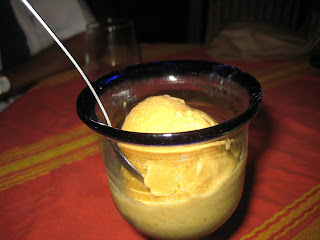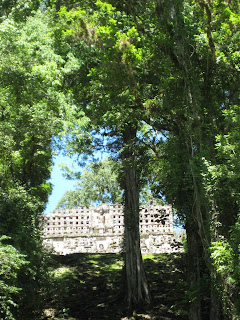 |
| Ruins in Yaxchilan |
From Mexico City we flew to Villahermosa (in the state of Tabasco) where the Governor had apparently been doing terribly corrupt things and is now fighting some legal battles. Tabasco has hit the headlines for this! It is also known for its sauce and for its ancient Olmec ceremonial site, La Venta, which has now been converted into an outdoor museum that contains (amongst other things) colossal Olmec basalt heads (the largest being over two metres tall).
We had no time to stop here, we immediately took a bus to Palenque and walked from the bus station to our hotel in the tiny town. Guide books do not rate the town highly, advising people to stay outside in the lush forest guest houses and hotels. But we liked the town, with its tiny lanes - some green, shaded and quiet and some bustling with people and sounds of loud speakers and generators interspersed with small, interesting shops.
We stayed in hotel Chablis, a 'standard hotel' which we found very clean, comfortable and friendly. It had a courtyard filled with beautiful plants and walls painted in warm shades of off white, yellow and orange. The food was good and the service friendly.
 |
| Flowers in the hotel courtyard |
The first evening, we just walked around to get our bearings. Everything in this town is within walking distance, which makes it easy to shop, eat and equip oneself for travel. It's also a blessing because the taxi (and minivan) drivers, like drivers everywhere, over-charge all tourists. There are regular vans (with irregular prices!) that take one to various tourist destinations around Palenque. We selected one amongst the many small travel agencies and booked two seats in a van that was going to Yaxchilan and Bonampak the following day. Then we bought some supplies and headed back towards our hotel for dinner.
We ate in an elegant restaurant close to the hotel, that served a fixed price, three course meal. It was a delicious dinner that began with glasses of house wine, tacos and salsa and continued till we were too full to move.
 |
| Maya Canada restaurant |
 |
| Tacos and salsa |
 |
| Soup made of local greens |
 |
| Vegetable soup |
 |
| Fish in cilantro sauce |
 |
| Grilled pork, banana and beans with tortillas |
 |
| Fresh mango ice cream |
The next day we rose early, ate some mangoes in our hotel room and were ready before sunrise, waiting for the van. The van arrived duly and we were packed in like sardines along with various other tourists, negotiating for space and air conditioning vents. We sped off towards the border of Mexico and Guatemala, stopping on the way for a pleasant buffet breakfast at a spot that every tourist bus seemed to halt at. Eggs in vast quantities (the Mexicans have an infinite and delicious variety of egg dishes), breads, beans, pork, tortillas, coffee, tea, fruit and more.
Continued, rather sleepily, towards the valley of the river Usumancinta, where Yaxchilan is located. Yaxchilan, rediscovered in 1881, was an important classic Mayan city, built strategically to control river commerce in the area. Many of the large structures were gradually taken over by forests but it is still an impressive sight and a very scenic location. The surviving monuments include stelae, altars and lintels with elaborate relief carvings and also distinctive 'roofcombs' that decorate the tops of the buildings. The reliefs and some inscribed texts tell us that Yaxchilan was ruled by kings of a single dynasty (and peaked in power between the 7th and 9th centuries A.D.); some important figures depicted are the rulers "Bird Jaguar" and "Shield Jaguar" and "Lady Xoc", the wife of Shield Jaguar.
 |
| Along the river Usmancinta |
 |
| Roofcombs of Yaxchilan |
 |
| A surviving relief |
To reach Yaxchilan, we took a boat a long way up the river; it was a beautiful ride with thick forest on either side. Then we walked around amidst the sprawling ruins, surrounded by water and greenery and saw (heard!) the howler monkeys making their eerie calls. Then we retraced our path, back through the forest, down the river and stopped at a very pleasant roadside place where long tables had been laid out for our lunch.
After a substantial meal, we headed southwards, to the valley of the Rio Lacanha, a tributary of the Usmancinta, to see the ruins of Bonampak. This city of 'Painted Walls' (as the name indicates) also dates to the same period as Yaxchilan. There was apparently a significant alliance between the two cities in the Classic Mayan period. Bonampak was more deeply hidden by the forest and came to light only in 1946.
Bonampak is in a reserved area so we could only use the reservation vehicles (which were rickety and completely airless) to the entrance. After that, it was a pleasant walk, past rows of small stalls where locals sold crafts and bead jewellery, to the actual ruins. Along the way I saw what seemed like small leaves scurrying along rapidly. It looked surreal but a closer glance revealed a row of ants carrying bits of leaves larger than themselves, across our path!
 |
| Walking leaves of Bonampak! |
Bonampak has a few small structures and carvings that are strewn around but the main area that still stands is a series of rooms filled with frescoes in vibrant colours (or whatever remains of them). The rooms show ritual preparations for war, scenes of war, celebrations of a victory and conclude with a depiction of a sacrificial ritual (rather bloodthirsty!) in which the victims are being offered to the gods. Replicas of the original paintings (or what they must have originally looked like) are on display at the Museum of Anthropology in Mexico City.
 |
| Frescoes |
 |
| More frescoes, in fragile condition |
After this we trooped back, tired, sat in the airless van, returned to our own van (which seemed luxurious by comparison) and quietly drove back. One by one, we were dropped off at our hotels. We had a quick (and very restorative) bath, then walked around in search of a place to eat. Discovered an excellent seafood restaurant - but more about that later (I'm running out of space)!